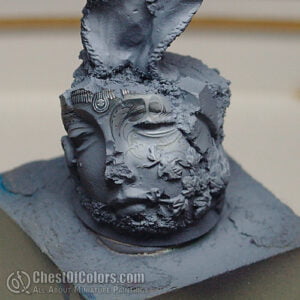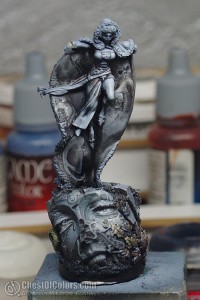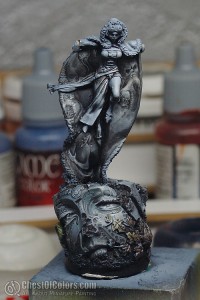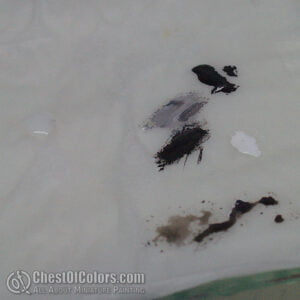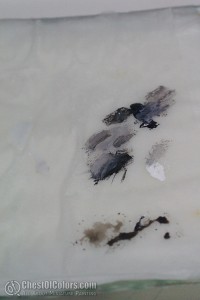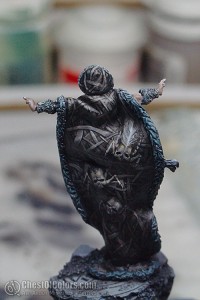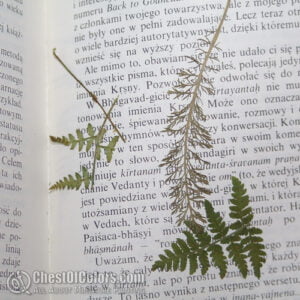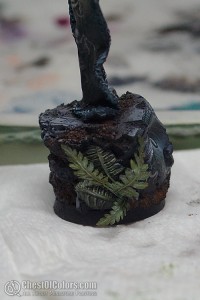Welcome to the article devoted to painting a whole warband. I will try to give you a step by step photo report. And the main actors will be Immortals from Asmodee/Cipher Studios.

Stage 1: Know your models
So we spent few euro or dollars, bought some cool looking models and it is time to have a good look what did you get. Maybe there are some parts missing? Maybe there are some miscasts?
If everything is ok, then now is the last call to have an idea how to paint the warband. What theme or background story? What color scheme? What units? What bases?
In my case the answers are no theme, original red-gold scheme, all units, Scibor‘s bases. It makes putting such group easier when there is a clear idea in your head. I know I am not being original, but this is also a decision later to stick to. 😉
So I take a good look at all the miniatures and put in separate piles. I try to, without glue, put these together and see if the parts match. Now is the perfect time to think about conversions and to look for extra parts in your bits box. If you found something there, just put it on the pile.

Stage 2: Removing mould lines and putting models together
Those models are supposed to fight on the table and we all know what happens to them when transporting or falling over on the table. That is why I try to pin the parts together. Tools that I use:

The pins which will hold the parts together are done (or better cut) from paper clips:

There should be also a picture of super glue or any metal glue, that glues the metal parts in few seconds. 🙂
A word about mould lines… I hate them! To clean them, takes a lot of time, but I see no other way. This job takes plenty of time, but it is simple. Believe me, it is worth to clean the miniatures from them. Later they will take a lot of the miniatures’ beauty away. I spent 2 evenings to clean all the parts from mould lines, but this job needs to be done – even on tabletop miniatures! Now, when all the parts are separate and easy to reach, it is the best time to remove them. Later it will won’t be easier. 😉
So let’s move to some examples – this djin has be cleaned from mould lines and all the parts are together (so that I won’t forget anything).

First I try to glue the biggest parts, in this case it is the torso. You can see on the picture a small cut from pater clip (called a pin) and two holes (drilled by me) in both parts of the torso. Before you glue – try to pin the parts without glue – if it’s ok, put some glue on the parts and into the pinning holes. If not then maybe the pin is to long or the holes too small?

To be sure that you drill the holes in perfect positions on both parts, try this simple trick:
- Drill a hole in one part,
- Put some paint around the hole,
- Try both parts together (with your fingers, not glue),
- Remove the second part and you should see the exact place where to drill.


And there we have a finished cleaned and pinned djin.

While removing mould lines from a ‘froggy warrior’ I accidentally broke the lance into two parts. It happens quite often, when the parts are small and fragile.

So what did I do – first I finished removing all the mould lines:

… and drilled holes in both parts and pinned them:

I also had a bit of problems with glueing the small parts with the torso, but with the help from pincette it was much easier. Here are the horns that are supposed to go on the shoulder pads:

I stick glued and pinned models together on cork. It makes further steps, like cleaning/gap filling/painting, much easier. You can easily rotate the cork and not touch the miniature. Another benefit is that when you clean the miniature (more to come), it won’t get dirty or greasy from fingers.
At the end of this step we get something like this:

Stage 3: Preparing for painting
All miniatures are on cork, waiting to be painted. Before we go to this step, there are some more things to be done. Usually glued minis have gaps, holes that don’t look nice. With these tools I will fill them:


Here is a mercenary djin with filled gaps.

I must admit, that using liquid green stuff from Games Workshop helps a lot. Filling small gaps isn’t a problem, but sometimes the gaps are too big, just like here:

The best way is to use normal green stuff or any other putty.
Now we are almost ready with putting undercoat, almost… We were touching the miniatures with dirty hands and the miniatures need a wash, so that the undercoat spray will hold on the miniature better. It will also remove any fat or oils from manufacturing process. We just need an old tooth brush, soap and dish washing liquid.

Pour some hot water and gently wash the miniature. I had no problems will super glue losing its characteristic because of water, so I can say it is safe!

Stage 4: Priming
Give the miniatures a day or two to dry and now we can finally prime the miniatures. This time I have used the Tamiya grey primer:

The from a distance of 30cm I spray each miniature 3 times:
[list class=bullet-2]
from each side (vertically)from top (from each side)from below (from each side too)I just hate when later there are some not covered places on a miniature and the paint doesn’t stick.



And there you have it, now we can finally start to paint the Immortals. You may think and say that it is way too much for all those steps before painting. I think it is worth to spend 2-3 evenings longer to have no problems later.
Stage 5: Painting human skin
It is important to plan the painting on all miniatures in a band. I thought the best option will be to paint the biggest areas first. That is why I started with human skin.
Step 1
First I’ve created a base color:
[list class=bullet-2]
pink 10%Bronzed Flesh 20%white 10%Elf Flesh 60%You might wonder why a bit of pink. 🙂 Well it is because in my opinion it gives a more natural look and makes the skin look more interesting. The paint was diluted 1:1 with water, so I had to cover the skin twice with the base color.


Step 2
Then I gave the whole skin a wash of Ogryn Flesh and Devlan Mud in the deepest shadows.





Step 3
When the washed surface was really dry (I waited about 30 minutes), I covered the muscles with the base color plus I added some more white to the mix.




Step 4
For the final highlight I mixed 40% base color with white.


Stage 6: Painting the creature’s skin
Step 1
Once again I started with making a base color:
[list class=bullet-2]
Hormagaunt Purple 20%Elf Flesh 40%Menoth White 40%There is only a small bit of purpule, but it is very visible. It is because Hormagaunt Purple is a foundation paint and those have much more pigment in it.

Step 2
Leviathan Purple wash and a bit of purple + black wash in those deepest shadows.



Step 3
Just like with the human skin, I highlighted the muscles with base color.



Step 4
Top places were highlighted with 50:50 mix of base color and white.



At this stage I think I can say I am 25% done. 🙂 That is the biggest advantage when choosing the correct order of painting – you get the results fast and you stay motivated. 🙂
Stage 7: Painting the red clothes
Now we come to the best part, well in my opinion, painting the red parts. I know an easy way how to paint good looking reds and now I will share my secret with you. 😉
The secret is simple when it comes to red, there are two important things:
- What color is under the red,
- Don’t highlight the red, just darken it.
Step 1
As always I make a base color mix and cover the whole parts:
[list class=bullet-2]
Blood Red 30%Scrab Red 50%Dark Flesh 20%


Step 2
To the base color I add more Blood Red and pink.



Step 3
For the final and brightest highlights there is just Blood Red & white.



Step 4
Now comes the most important part. Paint pure Blood Red diluted with water, on all those highlighted areas. Do you now see the richness of red color?



Step 5
To make the red looking more interesting and more contrasting. I did a wash with Blood Red wash, a bit of black, purple, Scorched Brown and dark blue. Wash the deepest areas with this mix.



This technique seems to be very intensive, but as you can see on the pictures you don’t have to be that accurate most of the time. 🙂 Even though it is very simple, I find it excellent for table top painting.
So now the Immortals warband is 50% finished.


Stage 8: Bases
As already mentioned for the bases, I have decided to buy them from Scibor Miniatures. First of all they were cleaned and washed in water and soap. To save a bit of the money I bought a set with only heads. Seven bases I did on my own, trying to keep them similar to the ready ones, using just those heads, cork and sand.

To make basecoating and painting easier, I wrapped a bit of adhesive tape on a piece of plastic. You can also buy a two side tape, that makes the whole job much easier.

Everything was basecoated, and since I ran out of the grey primer, I had to use black one. 🙂

Citadel Foundation brown paint was used to paint the ground.

And the I just highlighted the earth with Bleached Bone by drybrushing.

The stones were base coated with Citadel Foundation grey.

Then I drybrushed it with Codex Grey.

Another drybrush with Games Workshop‘s Space Wolves Grey…


The last stage was to drybrush with pure Skull White only at some of the most visible places.

The flowers were painted green and dry brushed with yellow, some static grass was ‘planted’ and the rims were painted dark brown:

Stage 9: Painting white
Because the miniatures were primed with grey, I didn’t have much to do here. This is how they looked after priming:

Then I heavily diluted the Games Workshop‘s Codex Grey with a bit of blue to make a wash:

After that I just highlighted with white:


Stage 10: Painting metallics
I already told you, that I paint in a way to cover the biggest surfaces first. After painting the skin, reds and white now is the time to paint some gold and silver. I was painting them together at the same time.
For gold I first used Games Workshop‘s Shining Gold and washed it with Gryphone Sepia:

Then with Burnished Gold I highlighted the most visible scales on the armour and shoulder pads. For the silver parts I have used Chainmail Silver.

The silver parts were light lighted with Mithril Silver.


Then the silver was washed with Badab Black wash.


And again with the same wash. 🙂 Just to make the silver look older.

Then while I was painting the ethereal smoke, I came up with an idea to make the metallics look more interesting and break the color. I painted small areas with very diluted Scaly Green to make patina.




As you can see, the miniatures are already 90% done!
Stage 11: Painting ethereal smoke
This one also goes really fast. First wash the smoke/cloud with grey.

Then comes a wash with a mix of Scaly Green and Scorpion Green. That mixture goes into the deepest areas. At this stage if you would like the smoke to have different color, i.e. purple, you could mix some other paints.


At the very end with white paint I just highlighted some areas to make the contrast stronger.

And that’s it…
Because of the batch painting the war band was fully painted in 3 months. In case I didn’t paint every evening, so it is possible to finish them in much shorter time.
I already hear you asking – what about not painted parts? Well those parts were painted just using one paint only. The painting colors were really simple:
[list class=bullet-2]
hair – Chaos Black, drybrush with Codex Greysticks – Scorched Brownshoes – Bestial Brownleather strips – Gore RedThe point was to have a painted war band in a very short time, that is why I tried to focus on the biggest and most visible surfaces.
Now it’s time for some final photos.
Finished Hell Dorado Immortals














My both Hell Dorado armies together:

Please give me suggestions how to show, explain things better. Everything that could make such articles more interesting and informative. Ask many questions, tell me if I didn’t explain something clearly.
Thank you for support. 🙂
— Sea.man









































































